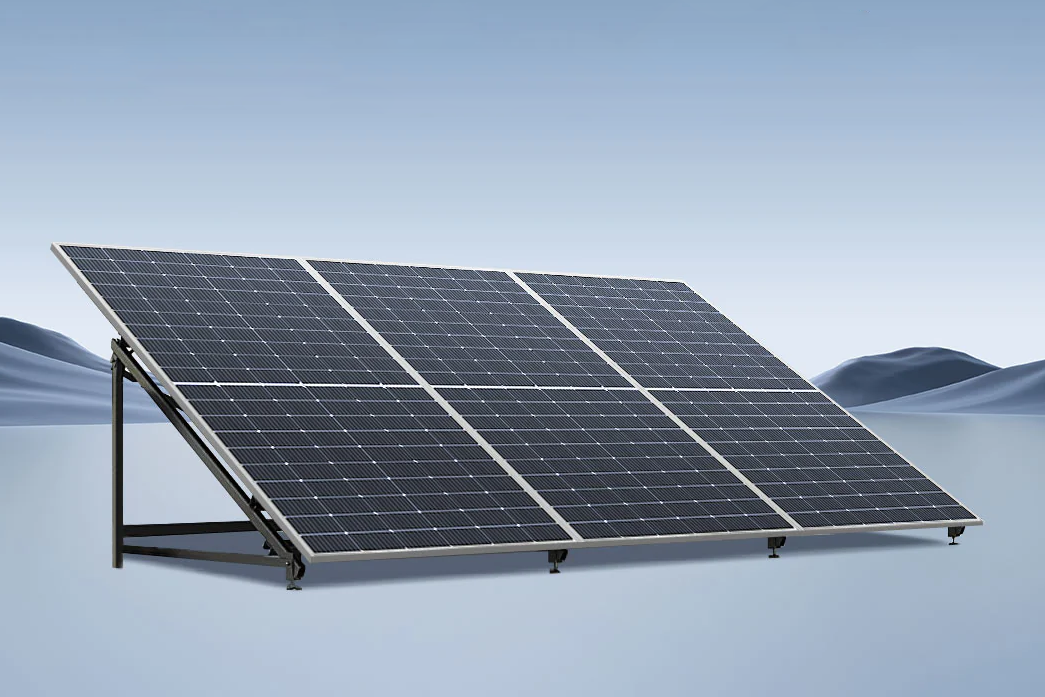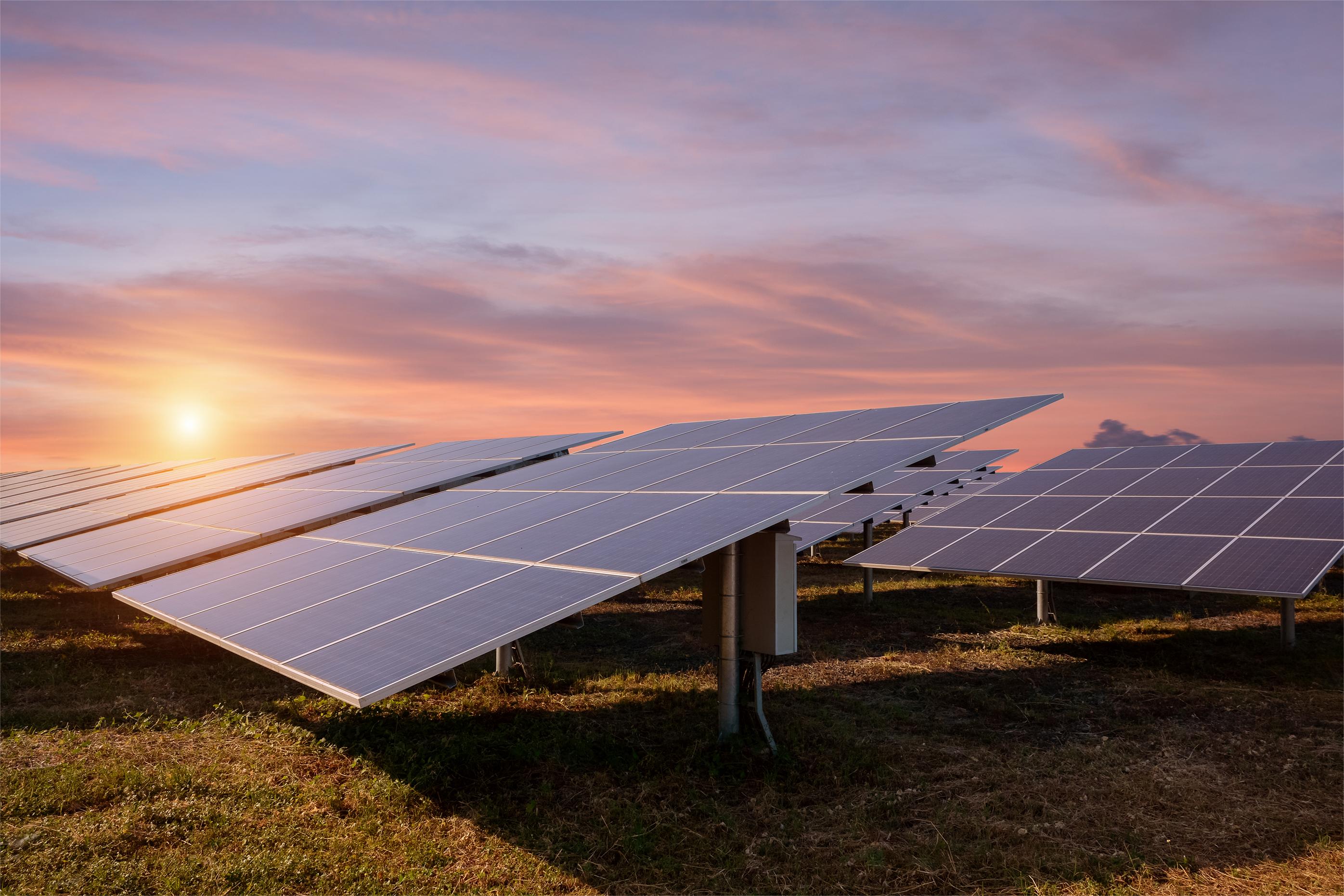Demi Moreno- Mar. 19 2024
What Are Bifacial Solar Panels and How Do They Work?
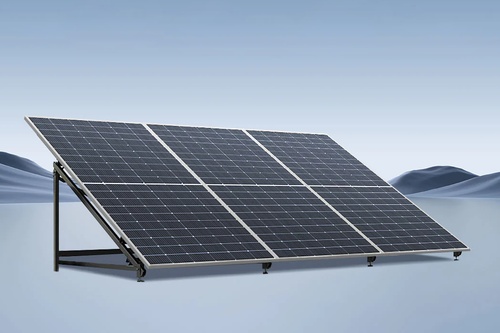
In the early days of solar energy, single-sided solar panels were the norm, capturing sunlight from the front only. However, the pursuit of higher solar energy efficiency led to the development of bifacial solar panels. These panels can capture sunlight from both the front and back, including reflected light, making them more efficient at energy generation. In 2010, the first commercial bifacial solar panels were introduced, gradually gaining acceptance in the market. Bifacial solar panels are a relatively new solar technology designed to boost the efficiency of solar panels. They have been gaining market share, especially in specific application areas.
TABLE OF CONTENTS:
· What Are Bifacial Solar Panels?
· Advantages and Disadvantages
· Comparison: Bifacial Panels vs. Monofacial Panels
· Where Can Bifacial Solar Panels Be Installed?
· How to Install Bifacial Solar Panels: A Comprehensive Guide
· What to Keep in Mind During Setup?
· Why SunGoldPower Bifacial Solar Panels Are Worth?

Ways to convert your traffic to sales
Bifacial solar panels are designed to absorb light from both the front and back simultaneously, which includes light reflected from the ground, buildings, clouds, and other surfaces. This feature gives them higher energy generation potential under varying environmental conditions. However, they often come with higher manufacturing and installation costs, making them more suitable for specific applications like solar farms and commercial solar systems.
Components of Bifacial Solar Panels
The typical structure of bifacial solar panels includes several key components that work together to capture solar energy and convert it into electricity. These components include:
· Solar Cells:
These are the core elements of bifacial solar panels, typically made from silicon materials, either polycrystalline or monocrystalline. They are responsible for the photovoltaic effect, converting solar radiation into DC electrical energy.
· Front Glass Cover:
The front of bifacial solar panels is usually covered with a transparent glass panel to protect the solar cells from environmental factors while allowing sunlight to pass through. This layer often has anti-UV and anti-reflective coatings to enhance light absorption.
· Back Glass Cover:
Unlike traditional solar panels, bifacial solar panels have a back glass cover, enabling them to capture light from the rear. This back cover is typically transparent, allowing light to pass through while providing protection.
· Solar Cell Interconnections:
The front and back of the solar cells connect to the panel's electrical leads. These connections transfer electricity from the cells to the panel's output connectors, consolidating the power at a single output port.
· Support Structures and Frames:
Bifacial solar panels typically include support structures and frames made from metals or other sturdy materials to ensure the stability and durability of the panels.
· Reflective Backsheet (Optional):
Some bifacial solar panels may include a reflective backsheet beneath the back glass cover, increasing the utilization of reflected light. This can improve energy generation efficiency.
The design of bifacial solar panels aims to maximize light absorption while providing protection for long-term reliability. These components work together to allow bifacial solar panels to capture light from both the front and back, enhancing the efficiency of solar systems.
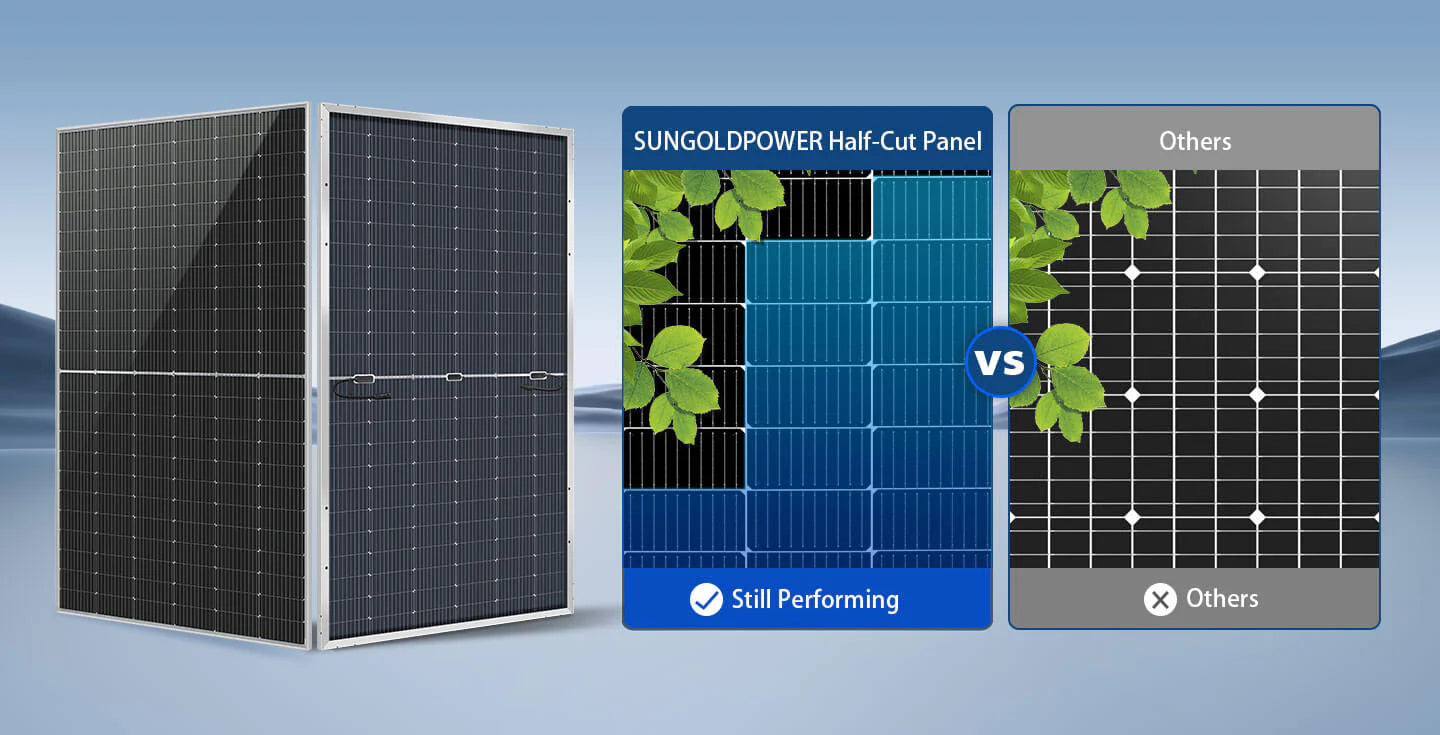
Advantages and Disadvantages
Bifacial solar panels have made significant strides in the renewable energy landscape, providing distinct advantages while also presenting a set of potential drawbacks. In this blog, we'll delve into the pros and cons of these innovative solar panels.
Advantages:
1. Enhanced Energy Production: The foremost advantage of bifacial solar panels is their unique ability to harness sunlight from both the front and back, encompassing reflections from the ground and other surfaces. This results in a remarkable increase in energy production efficiency, often exceeding 10% to 30% additional energy output.
2. Adaptability to Diverse Environments: Bifacial solar panels perform exceptionally well in a variety of environmental settings, including ground installations, rooftop placements, and regions with reflective surfaces, such as snow-covered areas.
3. Customizable Angles and Heights: These panels offer heightened flexibility in adjusting their angles and heights to cater to different installation needs, allowing for optimal sunlight absorption.
4. Eco-Friendly Impact: By generating more electricity within the same surface area, bifacial solar panels reduce the required land and resource footprint, contributing to a more environmentally sustainable solution.
5. Potential for Innovative Applications: Bifacial solar panels lend themselves to inventive applications like solar architecture, landscape design, and solar shading walls, combining functionality with aesthetics.
Disadvantages:
1. Higher Initial Costs: Bifacial solar panels often come with a higher price tag compared to traditional single-sided panels, impacting the initial investment required for a project.
2. Specialized Installation Demands: Due to their more intricate installation and positioning requirements, bifacial solar panels necessitate a higher degree of expertise and experience, potentially leading to increased installation expenses.
3. Increased Weight: Bifacial panels tend to be heavier than their single-sided counterparts, often requiring sturdier support structures. This added weight can result in greater engineering complexity and costs.
4. Sensitivity to Shading: The ability to capture light from the rear makes bifacial panels more sensitive to shading issues, demanding additional attention and management in shading-prone conditions.
Bifacial solar panels undoubtedly offer remarkable benefits, notably higher energy production potential and adaptability to various settings. However, they do come with the drawback of higher costs and specialized installation demands. When deciding whether to integrate bifacial panels into a project, it's essential to carefully weigh their advantages and disadvantages in conjunction with the specific requirements of the project. Ultimately, the choice should align with your project's objectives and long-term vision for a sustainable energy future.
Comparison: Bifacial Panels vs. Monofacial Panels
Bifacial solar panels have the potential for higher efficiency compared to monofacial panels. This is because bifacial solar panels can absorb light from two directions (the front and back), including light that is reflected from the ground and other surfaces, thus enhancing energy production efficiency.
Bifacial Solar Panels:
Bifacial solar panels showcase remarkable efficiency, typically ranging between 20% to 25%. However, the exact efficiency figures depend on factors such as the type of solar cells used and the manufacturing process. These panels capitalize on their ability to capture sunlight from both the front and back, with enhanced performance observed in scenarios involving ground-level installations and surfaces with reflective properties.
Monofacial Solar Panels:
In contrast, traditional single-sided solar panels exhibit lower efficiency levels, typically ranging from 15% to 20%. They have the limitation of capturing sunlight from only one direction, usually the front surface, thereby missing out on the potential energy from other directions.
These efficiency figures underscore the advantages of bifacial solar panels, making them a compelling choice for projects where maximizing energy generation is a primary objective. The increased energy output is a testament to the power of harnessing sunlight from multiple directions, ultimately contributing to a more sustainable and efficient solar energy solution.
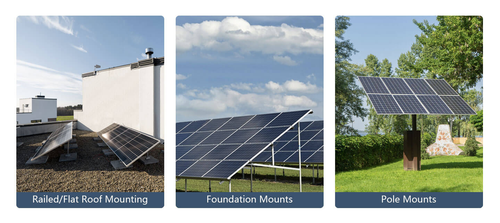
Where Can Bifacial Solar Panels Be Installed?
Bifacial solar panels are suitable for various scenarios and locations, primarily due to their ability to generate energy from both sides. They are recommended for:
· Ground Installations: Ideal for large-scale solar farms, they can increase energy generation efficiency by capturing light from both directions.
· Snowy Regions: Bifacial panels can make good use of light reflected from snow, enhancing energy production in snowy areas.
· Building Integration: They can be used in solar architecture, such as solar windows, roofing tiles, and building facades, providing both power and aesthetic value.
· Shading Walls with Photovoltaic Coverage: These panels can create shading walls with photovoltaic coverage, offering energy generation and improving aesthetics.
· Mining Industry: Bifacial panels can provide power, particularly in remote mining projects with ample sunlight.
· Agricultural Land: In agricultural areas, they can supply power while providing shading for crop protection.
· Industrial Sites: Industrial sites with ample unused space can benefit from bifacial panels to meet their energy needs.
· Reclaimed Land: Unused land, like abandoned factories, docks, warehouses, or vacant lots, can be converted into assets generating electricity using bifacial solar panels.
Bifacial solar panels are best suited for projects that require high-efficiency solar power generation while also considering aesthetics, sustainability, and environmental factors. The choice of bifacial panels in various scenarios typically depends on specific project requirements, geographical location, and available space.
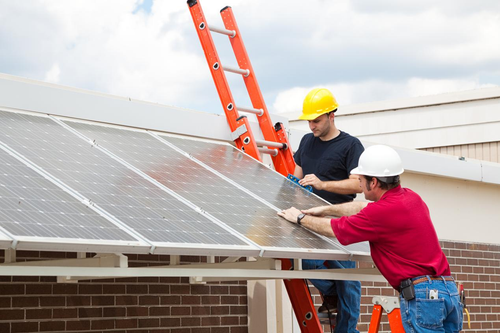
How to Install Bifacial Solar Panels: A Comprehensive Guide
Before installing bifacial solar panels, you will need some basic knowledge of solar energy and a set of tools. Below is a simple yet comprehensive step-by-step guide to help you install bifacial solar panels.
Step 1: Evaluate the Installation Location
Before you begin the installation of bifacial solar panels, it's essential to carefully assess the installation location. Choose a spot with ample sunlight exposure, minimal shading, and sturdy ground to support the mounting structure. Ideally, the panels should face south to maximize sunlight absorption.
Step 2: Obtain Necessary Permits and Documentation
Prior to commencing your installation, you may need to apply for relevant permits and documentation. These requirements vary by location, so be sure to check your local building codes and solar regulations to ensure your installation is legal and compliant.
Step 3: Procure Required Materials and Tools
Before starting the installation, you'll need to gather the following materials and tools:
√ Bifacial solar panels
√ Mounting structure
√ Solar inverter
√ Cables and connectors
√ Mounting hardware
√ Cable clamps
√ Grounding materials
√ Wires and condui
√ Safety equipment such as gloves, safety glasses, and harnesses
Step 4: Install the Mounting Structure
First, install the mounting structure to support the bifacial solar panels. Ensure that the structure is securely anchored to the ground and follow the manufacturer's guidelines for proper installation. These structures typically consist of posts and crossbeams to support the solar panels.
Step 5: Mount the Bifacial Solar Panels
Mount the bifacial solar panels on the support structure, making sure they are positioned to face the sun. You can use solar cables and connectors to link the panels to the inverter.
Step 6: Connect the Inverter
The solar inverter is a crucial component that converts the direct current (DC) generated by the solar panels into usable alternating current (AC). Connect the inverter and ensure it is properly linked to the panels and the grid.
Step 7: Wiring and Grounding
Install the wiring and conduit, making secure connections between all components. Simultaneously, ensure proper grounding to enhance system safety.
Step 8: Conduct Final Testing
After the installation is complete, perform a final system test to ensure everything is functioning correctly. Check the current generation and inverter performance to verify that everything is in working order.
Step 9: Monitoring and Maintenance
Once bifacial solar panels are installed, regular monitoring and maintenance are crucial. This ensures the long-term performance and benefits of your system.
The installation of bifacial solar panels may require expertise and skills, so it's advisable to seek the assistance of professionals if you are not familiar with the solar system installation process. This will ensure your system is safe, efficient, and compliant with all regulations and standards. Bifacial solar panels are an excellent choice for renewable energy, providing clean power for your home or commercial applications while reducing reliance on traditional energy sources.
What to Keep in Mind During Setup?
When installing a bifacial solar system, several essential considerations and best practices ensure system performance and safety. Here are some common installation tips:
· Proper Ground Preparation: Ensure thorough ground preparation, sturdy support structures, and an adequate foundation depth to support the weight of the solar array. Typically, the support structure's depth is about 30% to 50% of the structure's height.
· Spacing Between Arrays: Leave sufficient spacing between bifacial solar arrays to ensure adequate ventilation and reduce shading issues. Generally, it's recommended to maintain a space at least 1.5 to 2 times the array's height.
· Orientation and Angles: Adjust the orientation and angles of bifacial solar arrays based on geographical location and seasonal variations to maximize sunlight absorption. In general, the array's angle should be close to the geographical latitude, but this also depends on specific project requirements.
· Geographic Location and Shading Analysis: Conduct a geographic location and shading analysis before installation to determine the optimal positions for bifacial solar panels, avoiding shading and insufficient sunlight.
· Cables and Electrical Wiring: Ensure that cables and electrical wiring meet safety standards and are correctly connected to transfer electricity from the solar cells to the inverters efficiently.
· Ground Preparation and Array Bottom: For ground installations, ensure the ground is level and covered with suitable materials to prevent weed growth and soil erosion. Use durable materials at the bottom of the bifacial solar array for long-term stability.
· Safety: Ensure that installation and maintenance personnel strictly adhere to safety regulations, use appropriate personal protective equipment, and follow safety procedures.
· Performance Monitoring: Install a performance monitoring system to regularly track the solar system's performance and identify and address potential issues.
· Regular Maintenance: Perform routine maintenance, including cleaning the solar panel surfaces, inspecting the status of cables and connectors, to ensure the system operates in good condition.
These tips and best practices contribute to the reliability and performance of bifacial solar systems. It's important to note that specific installation requirements and best practices may vary due to project specifics, location, and local regulations. Therefore, working with a professional solar installation provider in your project planning is advisable to ensure all details are properly addressed.
Why SunGoldPower Bifacial Solar Panels Are Worth?
SunGoldPower 560W Bifacial Solar Panels deliver unparalleled value for your solar energy needs. With a robust power output of up to 728W and an impressive 30% increase in efficiency, these panels outshine conventional options.
Their durability, featuring an 11BB design and waterproof construction, ensures a long-lasting solution. These panels are backed by a 25-year warranty, guaranteeing dependable performance for decades.
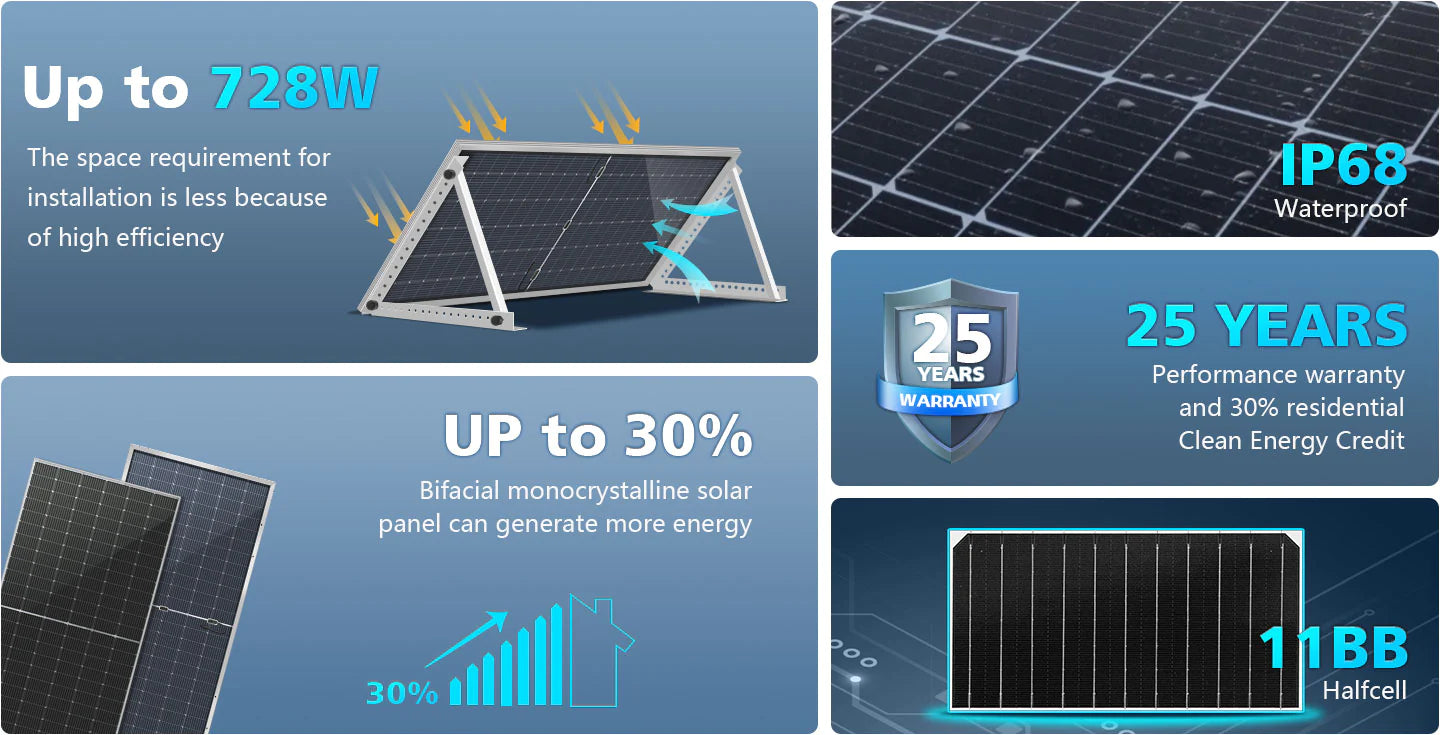
When you opt for SunGoldPower Bifacial Solar Panels, you're making a wise choice, investing not just in solar technology but in a sustainable, high-output future. Trust in SunGoldPower for your solar energy requirements.


